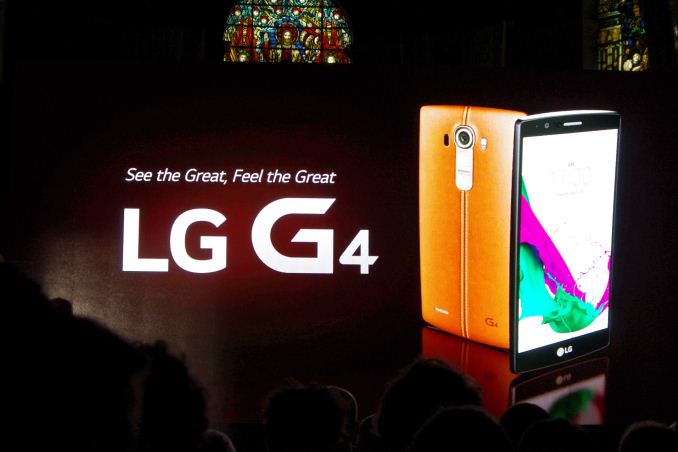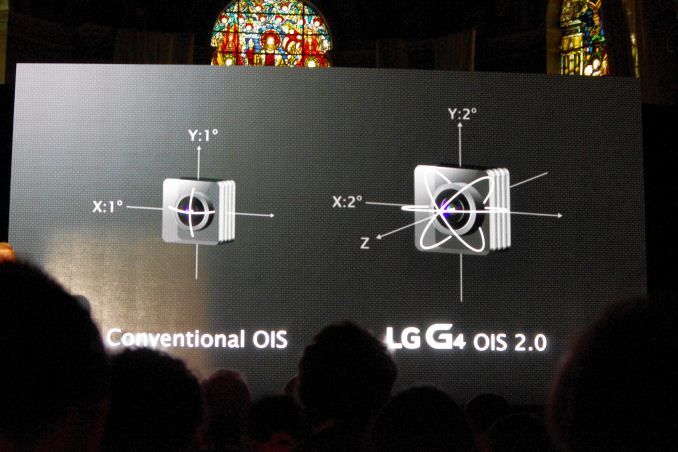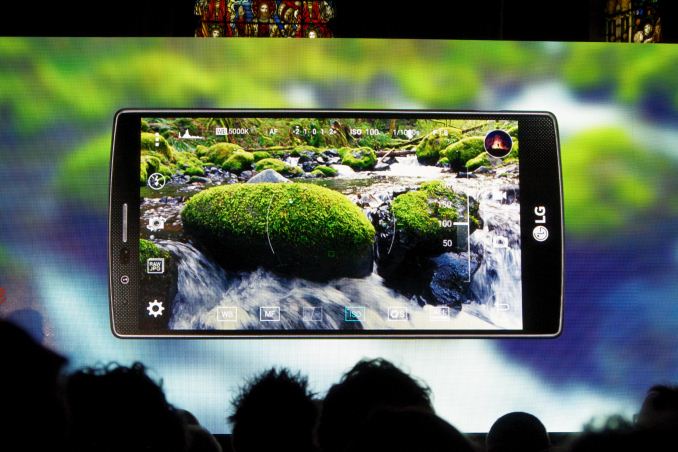LG Announces the G4: 5.5-inch QHD with Snapdragon 808
by Ian Cutress & Andrei Frumusanu on April 28, 2015 11:30 AM EST- Posted in
- Smartphones
- LG
- Mobile
- Snapdragon 808
- LG G4
- MSM8992

In a joint event between London and New York, LG has lifted the veil on the next iteration of its high-end smartphone, the G4. The G3's designs largely borrows from the G3 and iterates on it with a new slightly curved screen and optional leather back covers. The camera seems to be LG's core focus for this device, and we'll get back on those details in just a bit.
The G4 will be the first device to officially use the Snapdragon 808, Qualcomm’s MSM8992 big.LITTLE SoC arrangement that uses two ARM A57 cores in one cluster clocked in at 1.82GHz and four ARM A53s at 1.44GHz in the other. The GPU also uses a lower end Adreno 418 clocked in at 600MHz. Qualcomm avoided LPDDR4 in the S808, and thus remaines a LPDDR3 piece likely running at up to 933MHz.
While we're not too concerned with the resulting CPU performance and loss of two big cores, and slight frequency loss of the Snapdragon 808, it's the GPU which should see higher impact as 3D performance suffers a tad compared to the Snapdragon 810's Adreno 430. In our preliminary tests with the demo device, we see GFXBench Manhattan offscreen go down from 22.7fps to 15fps and T-Rex from 49fps down to 35fps when comparing the G4 to the HTC M9, which sports a FHD screen as opposed ot the QHD one we find in the LG device.
The detailed specification lists shows the iterative improvements over the G3, launched last year:
LG G3 |
LG G4 |
|
| SoC | MSM8974AC Snapdragon 801 4x Krait 400 @ 2.5 GHz |
MSM8992 Snapdragon 808 2xA57 @ 1.82GHz + 4xA53 @ 1.44GHz |
| GPU | Adreno 330 @ 578MHz | Adreno 418 @ 600MHz |
| RAM | 3GB LPDDR3 933MHz | 3GB LPDDR3 933MHz |
| NAND | 32GB NAND (eMMC 5.0) + microSD |
32GB NAND (eMMC 5.0) + microSD |
| Display | 5.5-inch 2560x1440 IPS LCD | 5.5-inch 2560x1440 IPS LCD |
| Network | 2G / 3G / 4G Qualcomm MDM9x25 UE Category 4 LTE |
2G / 3G / 4G Qualcomm X10 (Integrated) UE Category 9 LTE |
| Dimensions | 146.3 x 74.6 x 8.9 mm 149 grams |
148.9 x 76.1 x 6.3 - 9.8 mm 155 grams |
| Camera | 13MP rear camera, 1.12 µm pixels, 1/3.06" CMOS size, F/2.4. 2-axis OIS 2.1MP F/2.0 FFC |
16MP Sony IMX234 rear camera, 1.12µm pixels, 1/2.6" CMOS size F/1.8, 3-axis OIS 8MP Toshiba T4KA3 FFC |
| Battery | 3000 mAh (11.4 Wh) replaceable | 3000 mAh (11.4 Wh) replaceable |
| OS | Android 4.4.2 with LG UI | Android 5.1 with LGUX 4.0 |
| Connectivity | 802.11a/b/g/n/ac + BT 4.0, USB2.0, GPS/GNSS, MHL, DLNA, NFC | 802.11a/b/g/n/ac + BT 4.0 |
| SIM Size | MicroSIM | NanoSIM |
The screen size and resolution stay constant at 5.5" and QHD, but the device has an angular element to it, similar to the LG G Flex 2 but not as pronounced: The screen is touted to be a new generation IPS Quantum display. It looks like LG is claiming 20% gamut increase. The display has 50% increased contrast over the G3, achieving a total of 1500:1 contrast ratio. The G4 reintroduces Panel Self Refresh which was unfortunately missing from the G3, and this should vastly improve battery life over its predecessor.
The screen has a 3000mm radius curve throughout the phone's design that LG markets as "Slim Arc" design.
The phone comes in several different plastic and leather cover options. These are high-quality hand-produced genuine leather products. The plastic version sports a diamond pattern mimicking a metallic look. This also means the G4 is slightly bigger and heavier than the G3 as it comes at a increased 155g. The removable battery of the G4 remains similar to the G3 at 3000 mAh, and the SIM moves to the nano-size. The microSD slot remains an option for the G4.
The G4 gets a camera update, moving from a 13MP to a 16MP design that migrates from an F/2.4 to F/1.8, allowing for potentially better performance. We find a Sony IMX234 sensor, a unit we haven't yet seen used in any other devices. LG were keen to point the F/1.8 over Samsung’s F/1.9 on the latest Galaxy S6. The new OIS system dubbed "OIS 2.0" now offers a 3-axis gyroscope instead of the traditional 2-axis implementations in all current OIS devices. Another first is the implementation of a colour spectrum sensor next to the flash unit, and is able to read RGB and infrared light. LG is able to vastly improve white-balance and also increase clarity for more natural pictures.

The phone now also offers full manual control, with customizable ISO, exposure, shutter speed and white balance among other things. RAW format capture is also supported. Double clicking on the rear buttons already takes a picture within a second, LG is here taking another stab at Samsung's S6 as it only is able to open the camera app in the same time.
The front camera has been boosted to a 8MP Toshiba T4KA3 sensor and sports an improved gesture shot triggering function.
The volume rocker on the rear changes slightly, moving to a flatter central piece. The flash element of the camera in this area is a dual LED design, and we also find the microphone grille at the bottom. One of the elements LG seems to be pushing with the G4 is the design of the back cover, allowing for a replaceable leather rear while retaining the front facia that exhibits a faux carbon-fibre effect of sorts.
The device should be available this week in major markets. We’re currently waiting in line to get some hands-on time with the device, and hopefully on the list to get a sample to follow up from the LG G3 review.












121 Comments
View All Comments
mortimerr - Tuesday, April 28, 2015 - link
Wait how is this so? I'm actively staying far far away from any device using the 810 with 5.0. If anything it's a plus.And people saying less cores=less performance are..well shortsighted. The iPhone doesn't have 8 cores and still runs fine. The moto x 2013 didn't have a the same number of cores as the s5 but still ran better. It's not all about the number of cores. Anyone should be aware of that. It's about design and optimization. The s6 has the exynos and still deals with lag issues.
Vaibhav Sharma - Wednesday, April 29, 2015 - link
Whoa, you might be talking about galaxy s4, moto x first gen could not come close to galaxy s5. S4 pro in moto x is weaker than s4 almost equivalent to the soc used in nexus 4. Galaxy s5 was far more powerful.Drumsticks - Tuesday, April 28, 2015 - link
I've no concerns about the CPU performance of the SD 808, I am concerned about the GPU driving a QHD display.phoenix_rizzen - Wednesday, April 29, 2015 - link
The LG G3 uses a Snapdragon 801 SoC with an Adreno 330 GPU that just barely managed to push 1440p.The LG G4 uses a Snapdragon 808 SoC with an Adreno 418 GPU. There shouldn't be any issues wiht the 1440p screen. It's actually nice to see an OEM keep the resolution the same across generations, but increase the GPU power to work better with that resolution.
jospoortvliet - Thursday, April 30, 2015 - link
I doubt the 418 is so crazy much faster - Qualcomm promised20% and I bet that's optimistic. It will be fine, though, I guess the raw shading power won't be much more bit the GPU will be better at handling more pixels in less demanding tasks (more ROP power). And that is fine - not great in games, but for me - the last time my phone did run a game is over 2.years ago and that wasn't even a 3d game...jospoortvliet - Thursday, April 30, 2015 - link
I doubt the 418 is so crazy much faster - Qualcomm promised20% and I bet that's optimistic. It will be fine, though, I guess the raw shading power won't be much more bit the GPU will be better at handling more pixels in less demanding tasks (more ROP power). And that is fine - not great in games, but for me - the last time my phone did run a game is over 2.years ago and that wasn't even a 3d game...player911 - Monday, May 4, 2015 - link
The 808 performs better than the 810 because of the overheating\throttling issues. Plus the G4 (while not scoring as high) finishes benchmark tests faster then HTC and S6. Samsung chip is a beast though. The 810 is a huge let down.extide - Tuesday, April 28, 2015 - link
I think some people will prefer the 808. There really is little use for the 4x A57's anyways. The only real downside is the lower spec GPU. Also, you can get it without the leather, so that's a non-issue.jjj - Tuesday, April 28, 2015 - link
Anyone that might prefer the 808, should also know enough to not buy now and wait for much faster SoCs soon. Anyway 808 is less and will be seen as such by the vast majority. And i'm not counting on it being able to throttle a lot less than SD810 either.There should be some other features missing, like HVEC hardware encode.
djvita - Tuesday, April 28, 2015 - link
Soon as in next year soon? The 815 was a rumor, 820 gets sampled in Q3, long way ahead.